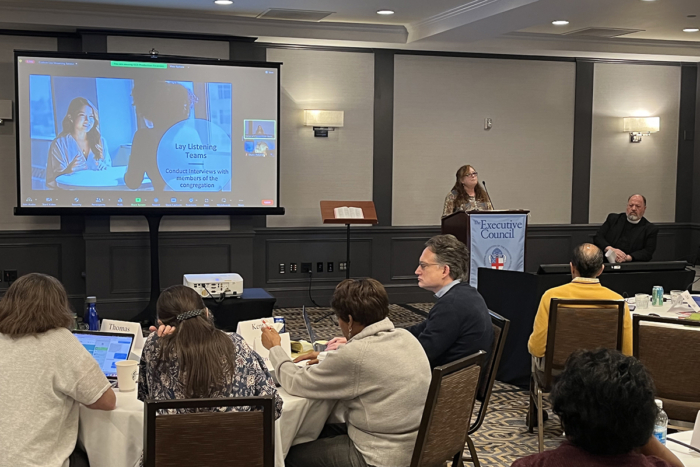Diocese of California finds hope in church revitalization through Vital + Thriving initiativePosted Feb 10, 2023 |
|

Amy Cook, the Diocese of California’s canon for faith and formation, talks about the Vital + Thriving Congregations initiative Feb. 10 at a meeting of Executive Council in San Francisco. Photo: David Paulsen/Episcopal News Service
[Episcopal News Service – San Francisco, California] The San Francisco Bay Area has never been a fertile ground for establishing Christian institutions as the East Coast, with its myriad and long-established churches. The values that tend to define the culture of the Bay Area are more rooted in the materialism of the Gold Rush of the mid-19th century, the Rev. Scot Sherman said in a presentation Feb. 10 to the Executive Council of The Episcopal Church.
Following that early Bay Area population boom, The Episcopal Church succeeded in planting missions and parishes in and around San Francisco, but today, the Diocese of California’s 75 congregations across six counties are embedded in “one of the most unchurched, de-churched areas of the country,” Sherman said. What his diocese shares with those on the East Coast is the trend of decline that is afflicting The Episcopal Church and all mainline Protestant denominations.
Yet Sherman had been invited to speak on the second day of Executive Council’s Feb. 9-12 meeting here to offer the hope of a possible model for revitalization. As a priest in the diocese, he is executive director of the Center for Church Innovation, which has partnered with the Diocese of California on an initiative called Vital + Thriving Congregations.
Cohorts of 13 congregations at a time are experimenting with new approaches to congregational redevelopment and lifting up lay leadership while collaborating in their learning. The pilot group of congregations began the three-year program in 2021, and a second cohort of 13 diverse congregations is underway now. With a third planned in fall 2023, it already is producing results, breathing new life into the participating congregations, said Amy Cook, the Diocese of California’s canon for faith and formation.
“There are new people that are stepping into leadership positions in the church that have never done so before,” Cook told the members of Executive Council, who were gathered in a conference room at the Westin St. Francis hotel in downtown San Francisco.
Participating congregations organize a “timeline” event as one of their first activities, identifying “great days” and “sad days” on timelines of the history of their churches, along with days when they saw hope and God at work, Cook said. This first-year phase of discovery also entails clergy coaching and lay leader training, fostering a kind of “Christian imagination” about each congregation’s future.
Participants also adopt “Dwelling in the Word” as their core spiritual practice, a way of turning to Scripture for guidance. The initiative puts much emphasis on Luke 10:1-12, in which Jesus sends disciples into the world to share his Good News and do good works.
The second year is spent experimenting with new ways of being the church in the world, and the final phase is focused on solidifying each congregation’s new sense of mission. All along the way, the diocese schedules times for participants to meet with each other and share their experiences, both successes and failures.
Sherman said the initiative is based on several core vitality practices for building what is commonly referred to as the Beloved Community, a term for interpersonal harmony that was popularized by the Rev. Martin Luther King Jr. Those practices include collaboration, community “embeddedness,” diversity, invitation and sustainability.
“But how do we get from where we are to there?” Sherman asked. In the past, churches often have seen vitality as a gap to identify and then fill. But change rarely happens in a straight line. Instead, Vital + Thriving is structured to account for the varied pace of adaptive change, between early adopters and skeptics, Sherman said, with laity learning from each other.
When the initiative launched, one of the first things Sherman noticed was that clergy often were personally exhausted, but they were inspired by the newfound excitement of the laity. “When we came together … the energy from team, from the lay people, it blew the roof off the building,” he said.
California Bishop Marc Andrus, who introduced Sherman and Cook, acknowledged that the churchwide decline in membership and attendance is profound and, if unchecked, could pose an existential threat to the church in the coming decades.
“But if there’s anything the resurrection of Jesus Christ teaches us, it’s that decline and death is not inevitable and God overcomes it,” Andrus said. “That is what we believe in the Diocese of California. We believe that God can make the church vital and thriving again.”
Through the diocese’s partnership with the Center for Church Innovation, Andrus said he hopes Vital + Thriving Congregations will be “a gift to you” and the wider church.
– David Paulsen is an editor and reporter for Episcopal News Service. He can be reached at dpaulsen@episcopalchurch.org.

Social Menu